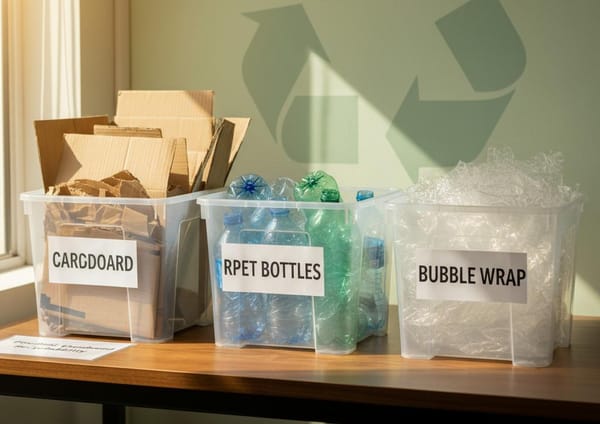Can renewable materials lower your carbon footprint?

Why renewable materials matter
Renewable materials are reshaping how we make, use, and dispose of everyday products. Because they come from replenishable sources, they help reduce reliance on fossil fuels and lower the environmental impact of manufacturing. In short, these materials offer a path to cleaner production and less waste.
As consumers and companies seek sustainable resources, interest in eco-friendly materials has surged. For example, bamboo, cork, and plant-based polymers replace single-use plastics in many applications. Therefore, choosing renewable materials can cut carbon footprints and ease pressure on landfills and oceans.
This article explains the rising relevance of renewable materials in simple terms. It covers practical benefits, trade-offs, and real-world uses so you can make informed choices. Read on to learn how small shifts in material choices can drive big environmental impact.
Image suggestion: wide green fields meeting rows of crops, with a close-up inset of natural material textures such as bamboo fibers, cork grain, and woven plant-based fabric to visually represent sustainability.
Types of renewable materials and where they come from
Renewable materials cover a wide range of options, and knowing the main groups helps you choose wisely. Because each type comes from different sustainable sources, they offer distinct benefits for products and for the planet. Below are the common categories and why they matter for biodegradability, low carbon impact, and green technology.
- Plant based fibersExamples include bamboo, hemp, jute, and organic cotton. These crops grow fast and often need less fertiliser than conventional crops, so they use fewer resources and store carbon as they grow. As a result, they are biodegradable and work well in textiles, straws, and packaging.
- Bio plastics and bio based polymersMaterials such as PLA, PHA, and cellulose acetate come from plants, sugar, or microbes. They can replace some single use plastics, however biodegradability depends on local composting conditions. For more on replacing plastics, see this link.
- Recycled materialsPost consumer recycled PET, recycled glass, and reclaimed wood reuse existing material streams. Recycling saves energy compared with making virgin material, and therefore cuts emissions and landfill pressure. Learn how renewable sources cut plastic waste at this link.
- Natural materials and bio compositesCork, sustainably sourced timber, mycelium foams, and plant fibre composites combine low embodied carbon with good performance. These materials support circular design and can be certified under sustainable forestry schemes.
- Algae and microbial materialsSeaweed, algae based polymers, and bacterial cellulose need little land and grow quickly. Moreover they show promise for low impact packaging and textiles, and they fit well with new green technology approaches.
For practical tips on how to use these materials to lower your environmental impact, see this link.
Environmental benefits of renewable materials
Renewable materials cut environmental harm in several direct ways. Because they come from sustainable resources, they often store more carbon during growth and use less fossil fuel in production. As a result, they reduce the overall carbon footprint of everyday products and packaging.
Key benefits at a glance
- Reduced carbon emissions. Many plant based fibres and bio based polymers require less fossil energy than petrochemical plastics, which lowers lifecycle greenhouse gas emissions. Some studies report significant savings depending on feedstock and processing.
- Less waste and landfill pressure. Renewable and biodegradable materials often break down more easily than conventional plastics, therefore reducing long term waste volumes and litter.
- Protection of ecosystems. By substituting single use plastics, renewable options help cut plastic leakage into rivers and oceans. Globally, plastic production and waste are large and growing; for context see Our World in Data.
- Resource efficiency and circularity. Using recycled content and rapidly renewable crops preserves finite resources and supports closed loop design. Consequently, manufacturers can lower raw material demand and energy use.
- Lower toxic burden. Many renewable materials avoid hazardous additives used in some plastics, therefore reducing chemical pollution in soils and waterways.
Taken together, these advantages make renewable materials a practical route to lower environmental impact. However, benefits vary by material, farming practice, and end of life management, so choose certified and responsibly sourced options where possible.
Quick comparison: renewable materials versus conventional materials
| Factor | Renewable materials | Conventional materials |
|---|---|---|
| Environmental impact (carbon footprint) | Generally lower lifecycle emissions because plants sequester carbon and many processes use less fossil energy | Often higher emissions due to fossil feedstocks and energy‑intensive production |
| Cost | Varies; some are competitive, others cost more due to scale and processing | Often cheaper at scale but price can fluctuate with oil markets |
| Availability | Increasing but variable by region and feedstock seasonality | Widely available and well-established supply chains |
| Biodegradability | Many are biodegradable or compostable under the right conditions | Mostly non-biodegradable; can persist in the environment for decades |
| Resource renewability | Sourced from rapidly renewable crops, recycled streams, or sustainably managed forests | Depend on finite fossil resources or unsustainably harvested materials |
| End‑of‑life options | Composting, recycling, or biodegradation possible; better for circular design | Recycling limited; often downcycled or landfilled |
| Chemical and toxic burden | Often lower if sourced and processed responsibly; fewer hazardous additives | Can contain persistent additives and toxic residues |
| Performance and durability | Suitable for many uses; some bio materials match performance of plastics | High and reliable performance for a wide range of applications |
Conclusion
Renewable materials offer a practical way to cut environmental impact while supporting long-term sustainability. Because they come from sustainable resources, they lower lifecycle carbon footprints and reduce dependence on fossil feedstocks. They also tend to generate less waste and, therefore, ease pressure on landfills and oceans.
Moreover, many eco-friendly materials are biodegradable or easier to recycle. This means manufacturers and consumers can close material loops and support circular design. At the same time, trade-offs exist: supply, price, and composting infrastructure vary by region. However, choosing certified and responsibly sourced options widens the benefits.
In short, renewable materials matter for the health of ecosystems and for future generations. They deliver tangible reductions in greenhouse gas emissions and toxic pollution when used thoughtfully. Therefore, companies should prioritise sustainable sourcing, and individuals should favour products made from plant-based fibres, recycled content, or bio-based polymers.
Finally, small choices add up. By preferring renewable materials, you help drive demand for green technology and resilient supply chains. Consider switching to renewable options today to reduce your carbon footprint and support a cleaner planet.



